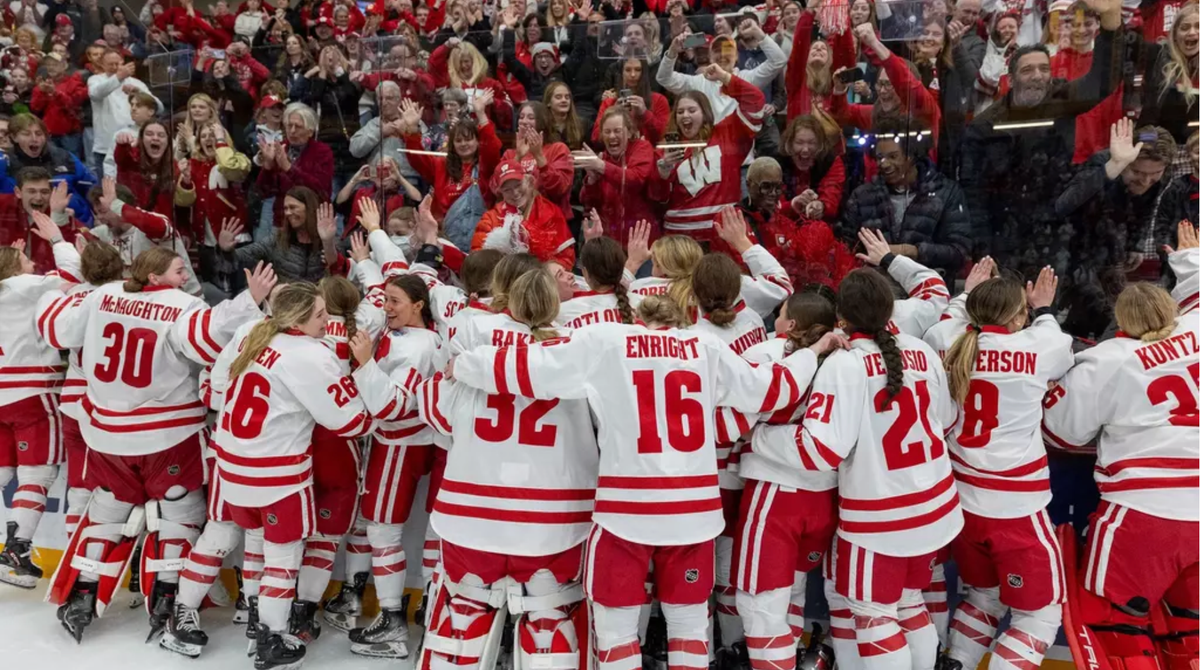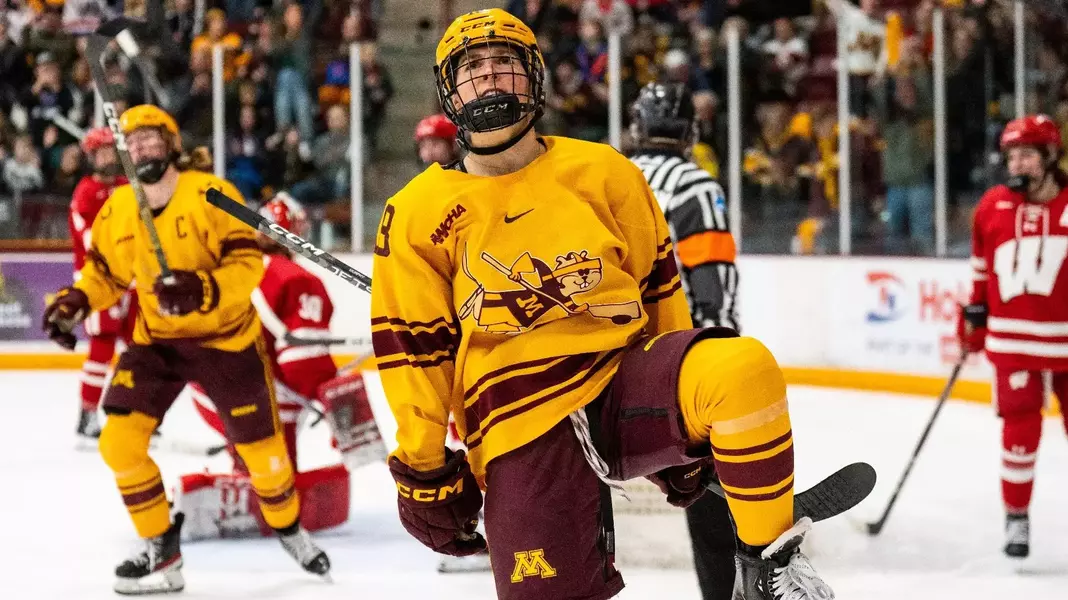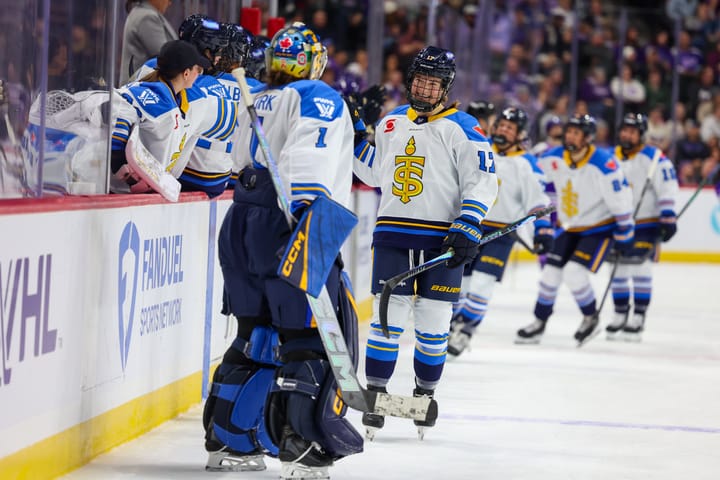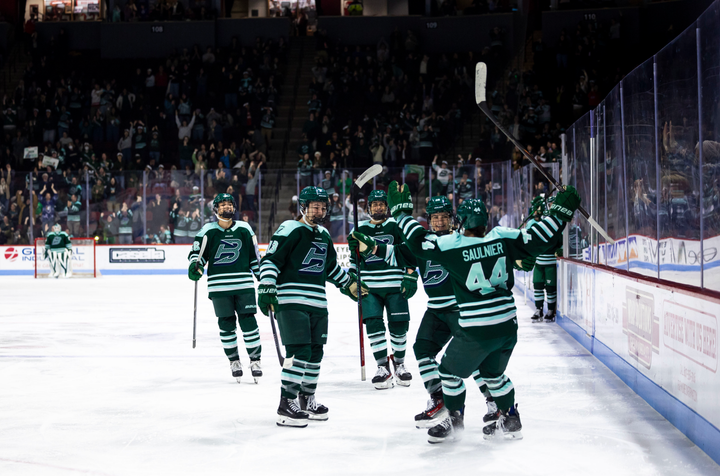Three PWHL Rules for the NCAA to Consider
Since the start, the PWHL has used their rulebook to push the game forward — what would some of those rules look like in the NCAA?

Have you ever looked through a rulebook and thought to yourself, I wish this rule existed in another league?
I mean, I can’t say I’ve read a rule book in depth, so I don’t really have an answer to my own question. What I have done, however, is seen interesting rules that have been implemented in certain leagues, and thought ‘hey, maybe this would be cool elsewhere’.
There have been many such cases in the last two years since the start of the PWHL. As I've watched the league grow and adapt their rule book, there have been certain rulings and guidelines that I believe would transfer over well into other levels of the game — especially into the NCAA.
The collegiate field is one of the biggest feeders into the PWHL to date, and as the players advance into the league in North America — and into other professional leagues as well — they’re entering a space with regulations they don’t always recognize. So, why not adapt some of the guidelines and apply them to the divisions of college play? It may end up benefiting the players, and various hockey federations in the long run.
So today, let’s look at three rules from the 2024-25 PWHL Rulebook that I’d like to see in an NCAA game at some point in the future.
1. Jailbreak Rule
This one may seem like an obvious choice, but it is because it’s so interesting.
In its inaugural season, the PWHL introduced the idea of a jailbreak, in which if a team killing off a penalty scores a goal while shorthanded, it negates the power play for the other team.
At first it seemed slightly gimmicky, but after watching the rules in action I’ve seen the beauty in it. There are a lot of teams in the NCAA that are outstanding while shorthanded — Penn State, for example, scored nine times while down a skater this past season — and it’s clear that the jailbreak rule would aid said teams overall.
Would it be tough for teams that give up goals while up a skater? Probably. But I think it would also allow for teams to focus more heavily on the defensive side of things in all capacities, and potentially could push the game forward in that regard as teams are forced to protect against the jailbreak. Additionally, the potential of the opposition's power play ending prematurely adds another layer to the heightened excitement of scoring while shorthanded.
BRING EM OUT, BRING EM OUT 🗣️
— PWHL (@thepwhlofficial) December 14, 2024
Season two has kicked off with not one, not two, but THREE jailbreak goals. Watch them all again ⬇️
PWHL x @sharkbeauty pic.twitter.com/trXIFWLFg0
Maybe it doesn’t have to be every type of penalty. For example, perhaps it’s only available on bench minors such as too many skaters on the ice. At the very least, I think it should be something that happens some of the time, even if just for a season to try it out. It’s been working in the PWHL so far, and I think it could be interesting to see it play out with more teams and their systems in the NCAA.
2. Bodychecking
Now, don’t get me wrong, I’m definitely not advocating for dangerous or harsh hitting whatsoever. However, what I am hoping for is that there be more of an emphasis on educating players on how to throw legal hits before they enter the professional sphere.
The NCAA, as of this moment, does not allow bodychecking of any kind in their game. In fact, it is often called a roughing or even a bodychecking penalty when contact occurs between players. Yes, there have been instances when these calls are not made. However, overall, there is still a heavy emphasis on not using the physical side of the game at the collegiate level.
Then, when players get to the PWHL or SDHL or other professional leagues that do allow body checking, those fresh out of college are somewhat on the back foot as they’re potentially not used to the more physical side of things. Do players still throw hard hits? Sure, I mean, look at the Frozen Four game between Minnesota and Wisconsin this past year. It was heavy-hit central. But they were also somewhat dangerous hits, and it was reflected in the way penalties were called on various players.
So, in order to protect players a little bit more, I’d like to see the NCAA work on introducing hits and the more physical aspect of things. It could go a long way to eliminating serious injuries that impact players throughout their careers, both in how they prepare to be on the receiving end of these hits, and in how they actually throw them themselves.

3. Standard Point System
Maybe this is just a bit of a gripe on my part, but across the five conferences in the NCAA, all but one of the leagues has the same point system. Four of the conferences follow the 3-2-1-0 point system, the same as the PWHL. This includes three points for a regulation win, two for an overtime or shootout victory, one for an overtime or shootout loss, and none for a defeat in regulation.
But in the ECAC, the lone hold out, if two teams tie within conference, they each walk away with 1.5 points.
Yes, a point and a half.
While I’m sure the ECAC has their reasons for their point system, and I know it’s complicated to switch the way wins and losses are counted (especially considering the NCAA changed the shootout rules within the last few years), I can’t help but wonder how a standardized system across all of the leagues would work.
The 3-2-1-0 system has seemingly worked the best, and it’s still adaptable to include ties in a way that isn’t seen in the PWHL. With the NPI or Pairwise somewhat complicated to understand, ensuring the point systems are not as complicated to figure out could aid newer fans.
It’s also interesting to think about how the conferences do their post-season tournament differently. In the WCHA, NEWHA, and ECAC, the first round of the playoffs is a best-of-three matchup, before single elimination the rest of the way. In the AHA, the quarterfinals is a single elimination game between the four bottom seeds, followed by the semifinals, which are a best-of-three series featuring the top-two seeds and the teams that advanced from the QF. And then we have Hockey East, where it’s single elimination the entire way through.
If anything, I think keeping that more conference-specific is interesting, especially considering the fact the national tournament is single-elimination. If there was more time in the schedule, a potential five game series like we see in the PWHL would be a nice way to shift, especially to give players more post-season contests to play.
In reverse, I wonder how a three-game series or the one-game quarterfinal could work in the PWHL this upcoming season. With the expansion of the league to Vancouver and Seattle, the assumption is that the Walter Cup playoffs will expand as well. Instead of best of five, perhaps they follow the AHA playoff format and do the one-off to eliminate two squads, before moving on to the best-of-five series the league has done to this point for the semifinals and finals.
Guess we’ll have to see what they decide, come the spring time. And see if the NCAA agrees with me next summer before the start of 2026-27 on any of my suggestions.
So while we wait, maybe I’ll go read the rulebooks in depth. I gotta figure out what goaltender interference is somehow, right?





Comments ()